how to microdose
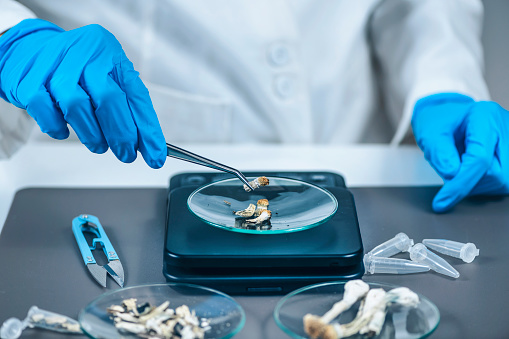
A few weeks ago, I heard the testimony of a working mom who effortlessly combines caring for her family and being productive at work. As I listened carefully, I noticed that her success was attributed to microdosing.
No doubt, the intake of a small amount of psychedelic substances is growing in popularity even if there is no sufficient scientific research in this practice. When we talk about microdosing, we have to look at the advantages and disadvantages.
what is microdosing
Microdosing is the practice of consuming small doses of psychedelic or hallucinogenic substances such as (LSD) lysergic acid diethylamide or psilocybin-containing mushrooms.
According to some user-generated reports, the consumption of small doses of psychedelics is not enough to cause a ‘trip’ or hallucinations that are associated with these drugs. As the popularity of microdosing increases, users have also reported some microdosing benefits and side effects.
microdosing psychedelics
Microdosing psychedelics simply means consuming small amounts of psychedelics drugs. Taking a full dose of psychedelic drugs can damage the body, but microdosing is not known to cause any severe damage.
microdosing benefits and challenges
Microdosing has some benefits as well as challenges. Although, the benefits and side effects of microdosing substances have not been properly researched.
benefits of microdosing
Just like we said earlier, there are benefits and challenges of microdosing. We would not start discussing the benefits and challenges of microdosing right away, let us start with the benefits.
Although, there is not enough scientific research and evidence to make a solid case for microdosing including the comparative research method using placebos.
However, microdose users report some users of microdosing psychedelic substances like LSD and psilocybin-containing mushrooms.
below are some common advantages of microdosing:
Based on research and user report, Improved mood is one of the common gains of microdosing. Microdosers have reported:
- improved mindfulness
- Improved focus
- Improved concentration
- Improved energy
- Increased creativity
- reduced anxiety
- reduced stress
- improved body functioning
- self-efficacy, including improved
- ambition, productivity, etc.
- reduced depression
Another major benefit of microdosing is improved mental health. In a popular study in psychopharmacology, researchers ask people their reason for microdosing. Did you know that 44% of
respondents perceived that their mental health was better as a result of microdosing?
These are other mental health-related benefits
- Improved brain functioning.
- Improved focus.
In summary, the commonly reported benefits of buy magic mushroom are improved mental health, mood focus and creativity.
Eligh B. Rethinking psychedelics: U of T study looks at the practice of microdosing to ease anxiety and sharpen focus. The University of Toronto News. 2018 [cited 2018 Aug 29];
what does microdosing involve?
When people microdose, they normally consume about a tenth of a recreational dose of a psychedelic substance, although doses vary between people. The dose is sub-hallucinogenic; people who microdose aren’t “tripping.” Microdosers go about their daily lives, many taking care of children or working in offices, expecting a little boost.
Although we don’t know what microdosing does (if anything), it is a growing trend. Some Silicon Valley entrepreneurs are becoming microdosing coaches, touting the purported benefits of microdosing.
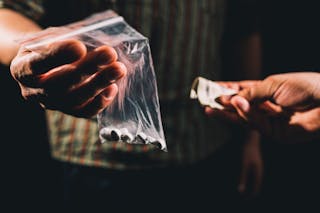
The illegal nature of psychedelics in most jurisdictions was the biggest concern for research participants. (Shutterstock)
A small scientific community has also started asking pre-defined questions about what microdosing may do, but we figured we’d ask people what they experience, from the ground up.
We recruited 909 participants from all over the world using forums like r/microdosing. In one section of our survey, 278 participants told us about the three main benefits of microdosing for them, and the three main challenges they had to cope with.
If you’re curious to see everything that people reported, our paper is available here. We are making the data available publicly, at no cost, as part of our commitment to Open Science.
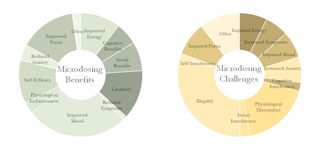
Categories of microdosing benefits and challenges from the published paper. These data indicate reported outcomes, not confirmed effects.
more confident, motivated and productive
The benefits our participants reported mostly match what people have been reporting anecdotally. They said microdosing helped with mood, focus, creativity, self-efficacy, energy and more.
These findings, like creativity, square well with our previous research.
Our approach was to take individual reports and classify them. This way we got an idea of how common each of these reports was, helping us guide future research down the most promising avenues.
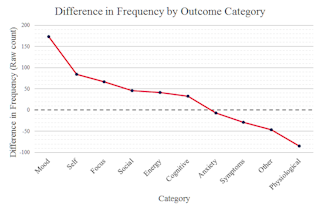
The difference in the raw count of reported benefits and challenges. Positive values indicate greater endorsement of benefits; negative values reflect a greater endorsement of challenges. Differences, regardless of magnitude, should be thought of as preliminary.
For example, the most commonly reported benefit was improved mood (26.6 per cent of people) making mood the highest-potential area for future research to focus on. Creativity is another obvious area.
Perhaps less intuitive is that many people reported microdosing made them more confident, motivated and productive, so this also seems worth researching.
In contrast, only 4.2 per cent of people mentioned reduced anxiety and several people reported increased anxiety, so studying microdosing for anxiety reduction seems less promising.
These data indicate perceived outcomes and do not indicate confirmed effects.
headaches, gastrointestinal issues, insomnia
The most common challenge was the illegality of the drugs and this was mentioned in almost a third of reports. In our coding of responses, illegality involved having to deal with the black market, social stigma around using illegal substances and difficulty with dose accuracy and purity.
(Microdosers should always test their dose: you never know what you get when you’re buying unregulated substances.)
This challenge is not due to microdosing itself so much as social policy and norms. As research on psychedelics grows, these substances may eventually be decriminalized or legalized, which could dispel the most common challenge reported in our sample.
Next up was physiological discomfort: in 18 per cent of reports, participants described headaches, gastrointestinal issues, insomnia and other unwanted side-effects of microdosing.
Research should examine these possible side effects and consider how they compare to the profiles of the many legal substances available, such as anti-depressants, which also cause side effects.

Participants also reported improved mood and reduced substance use on a pre-defined measure. Anxiety refers here to improvements in anxiety-related experiences, not to increased experience of anxiety.
Participants also mentioned other concerns, such as not knowing whether there could be harmful interactions between psychedelics and other medications and a lack of research evidence about the long-term effects of microdosing.
what’s next for microdosing research?
It is possible that microdosing psychedelics was unrelated to many of the benefits and challenges participants reported. People often feel better or worse even when taking totally inert substances, like sugar pills. This is commonly known as the placebo effect.
Randomized placebo-controlled trials are required to determine what the true outcomes of microdosing are, which is why we’re planning to run one soon.
Our results suggest that microdosers get a lot out of their use of psychedelics, while negative reports mostly focus on social and physiological concerns. Overall, participants reported less challenges than benefits, and they reported that the benefits were more important than the challenges.
There are still more unknowns than knowns when it comes to microdosing: does microdosing cause any of these effects, or is it all placebo? Could there be long-term negative consequences to microdosing? Are certain people more likely to experience specific benefits or challenges?
This study creates a road map for researchers to follow. We encourage researchers to test whether these benefits and challenges occur in a lab setting, as we will be doing in the coming months and years.
‘microdosers’ of psychedelics report improved mood, focus and creativity
rotem petranker, york university, canada, thomas anderson, university of toronto
Microdosing psychedelic is a growing trend that involves ingesting very small sub-hallucinogenic amounts of substances like LSD or dried psilocybin-containing mushrooms.
We ran a large-scale, pre-registered global research study asking participants to report what they like and dislike about microdosing.
The three most commonly reported benefits were: improved mood, increased focus and enhanced creativity.
The three most common challenges were: illegality (by a wide margin), physiological discomfort and “other concerns” such as the unknown risk profile of microdosing and forgetting to take a regular dose.
do you know that these benefits are grouped into 11 categories?
From the research done by harmreductionjournal.biomedcentral 11 categories were distilled which includes: improved mood (12.8%), improved focus (10.0%), creativity (9.4%), and improved energy (7.6%).
challenges of microdosing
Just as most things, microdosing has its challenges. The most common challenge with microdosing is the challenge of illegality. The challenge is with the black market and the social stigma that comes with buying illegal substances.
While some microdoser have reported improved mood focus and creativity as a result of microdosing psychedelic, others have reported some effects of microdosing.
The issue of impurity and accuracy of the dose is also one of the challenges of microdosing. There is also a challenge of testing the dose to know exactly what you are buying since the drug is not regulated.
Thomas Anderson & Rotem Petranker research reveals other effects of microdosing which includes:
- Insomnia
- stomach upset
- reduced appetite
- headaches
- Physiological discomfort
- Impaired focus
- Increased anxiety
- Impaired energy
- Social interference, etc.
According to Thomas Anderson & Rotem Petranker research, the effects of taking small amounts of psychedelic substances are based on reported outcomes and not conformed effects.
are there long-term effects of microdosing?
There are current limitations of microdosing research. They have been no research that states the long-term effects.
why do people microdose substances
People who microdose substances do it for different reasons. Microdosers take these drugs to improve their wellbeing and mental health.
On the other hand, microdosers that take a higher dose take it for recreation and also for spiritual activities.
microdosing questions and answers
a. is microdosing lsd harmful
b. can microdosing lsd make me more creative?
c. can microdosinghttp://Mushroomfarm.uk lsd result in improved mood?
d. can microdosing cure depression?
can substance use disorder be improved by taking small amounts of psychedelics?
Although there is scientific research to prove this, people that microdose LSD, psilocybin, and similar substances report that it has helped them with substance use disorder.
what substances do people microdose
Lysergic acid diethylamide (LSD) and psilocybin mushrooms (magic mushrooms) are the most common substances that people microdose. People microdose other psychedelics like:
- N,N-dimethyltryptamine (DMT) or the cactus peyote.
- ketamine
- cannabis
- methylenedioxyamphetamine (MDMA)
- methylphenidate (Ritalin)
- nicotine
- iboga
With all the different microdose substances available LSD and psilocybin are the most common substances microdose.
the way to microdose
People are curious about how they will go about microdosing. Despite the limited research about taking a small amount of psychedelic or hallucinogenic substances, it is difficult to say what works for everyone.
Based on research, the people who microdose often follows one of the two most popular protocols: The Fadiman Protocol or the StametsStack. The major difference between these approaches is how often one takes the microdose and how many ‘rest days’ are in between doses.
Before you decide to microdose, make sure you do your research and talk to your doctor to know what works for your body.
how do people microdose?
We have looked at how to microdose, now we are going to look at how people microdose the different psychedelic drugs. Even if there have been no sufficient scientific studies.
a. how to microdose cannabis
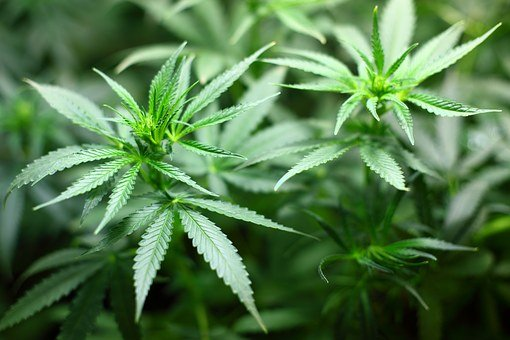
Cannabis is a natural plant that is most often smoked or turned into different kinds of butter, oils, and tinctures to transform common foods into psychoactive treats.
The dose
cannabis microdosing can range from one to five milligrams of THC and is best done in an edible.
b. how to microdose lsd
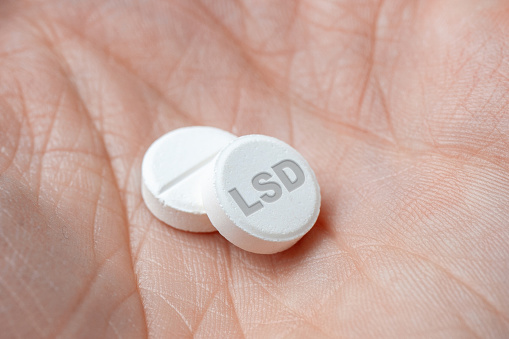
lysergic acid is a naturally occurring fungus that grows on bread (rye in particular), LSD is a manmade drug that harnesses its psychoactive effects.
The dose
A tincture is the best way to go when it comes to taking small amounts of the psychedelics. “LSD microdoses normally contain 5 micrograms to 15 micrograms.
c. how to microdose magic mushrooms
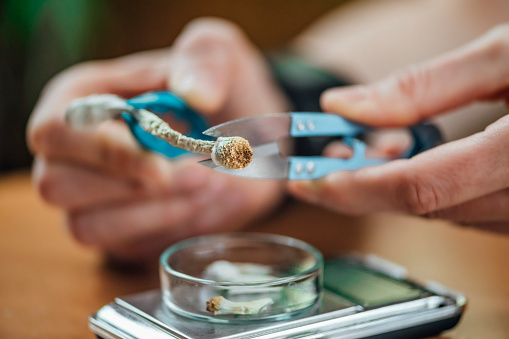
“magic mushrooms”, psychoactive chemicals from psilocybin, a naturally psychoactive found in a variety of mushroom species.
The dose
Psilocybin mushrooms are typically microdosed between 0.05 and 0.25 grams
microdose regiment

According to the Fadiman approach, people generally microdose once every three days for about a month — one day on, two days off.
If you are microdosing, then you would love to know why you should space your microdose intake.
Even if psychedelics are non-addictive, they can build up a tolerance if not properly spaced out. another thing to keep in mind is time. Microdose should be taken before 10:ooam.
are you experimenting with microdosing?
If you are experimenting with microdosing psychedelic substances like LSD, magic mushrooms, or other psychedelics it is good you know microdosing benefits and challenges
Note: A recent placebo-controlled study examined the experience of microdosing and suggests that these anecdotal benefits can be explained by the placebo effect.
The placebo effect shows the power of the brain to facilitate healing. This effect can be just as effective as an actual treatment.
background
Microdosing psychedelics is the practice of consuming very low, sub-hallucinogenic doses of a psychedelic substance, such as lysergic acid diethylamide (LSD) or psilocybin-containing mushrooms. According to media reports, the practice has grown in popularity, yet the scientific literature contains minimal research on this practice. There has been limited reporting on adverse events associated with tiny quantities of psychedelics, and the experiences of microdosers in community samples have not been categorized.
methods
In the present study, we develop a codebook of microdosing benefits and challenges (MDBC) based on the qualitative reports of a real-world sample of 278 microdosers.
results
We describe novel findings, both in terms of beneficial outcomes, such as improved mood (26.6%) and focus (14.8%), and in terms of challenging outcomes, such as physiological discomfort (18.0%) and increased anxiety (6.7%). We also show parallels between benefits and drawbacks and discuss the implications of these results. We probe for substance-dependent differences, finding that psilocybin-only users report the benefits of microdosing were more important than other users report.
conclusions
These mixed-methods results help summarize and frame the experiences reported by an active microdosing community as high-potential avenues for future scientific research. The MDBC taxonomy reported here informs future research, leveraging participant reports to distil the highest-potential intervention targets so research funding can be efficiently allocated. The research complements the full-dose literature as clinical treatments are developed and neuropharmacological mechanisms are sought. This framework aims to inform researchers and clinicians as experimental microdosing research begins in earnest in the years to come.
keynotes
Taking a small amount of psychedelic or hallucinogenic drugs that are not known to cause a trip as the case of psychedelic drugs.
Microdosers report benefits like problem-solving, improved creativity, reduced anxiety, improved focus, etc.
Petranker, who is also the associate director of the Psychedelic Studies Research Program at the University of Toronto and a PhD student at York University, says that there is still a gap in knowledge.
There are still few clinical trials on the benefits of taking little amounts of psychedelic substances. Until there are complete clinical trials, there may be no answers to the questions that people ask.
Despite some reports from microdoser that microdosing made them more confident, microdosing research is not yet popular. Microdosing has benefits and challenges.
microdosing psychedelics and mental health
Many people with mental health challenges want to know if they can microdose or what research has to say about microdosing psychedelics and mental health.
According to research, drugs like LSD or the ingredient of magic mushroom bring mental benefits may be due to the placebo effects.
Users say taking these tiny psychedelic drugs gets them high, but makes them more creative, and improves their mental health
Some trials suggest larger doses of psychedelics can help relieve anxiety, depression and other mental health conditions. But microdoses have been tested only in small, placebo-controlled trials, with mixed results
summary
- Microdosing typically involves taking a very small amount of classical hallucinogens, such as LSD or psilocybin mushrooms.
- Users report suggests that the practice improves mental health, reduces anxiety, and may even help keep the person focused or creative throughout the day.
- There is not much formal research into this practice yet, partly because most substances that people microdose are illegal and difficult to research.
- People with mental health disorders or symptoms should not use the practice to replace any treatment.
- According to the Fadiman approach, people generally microdose once every three days for about a month — one day

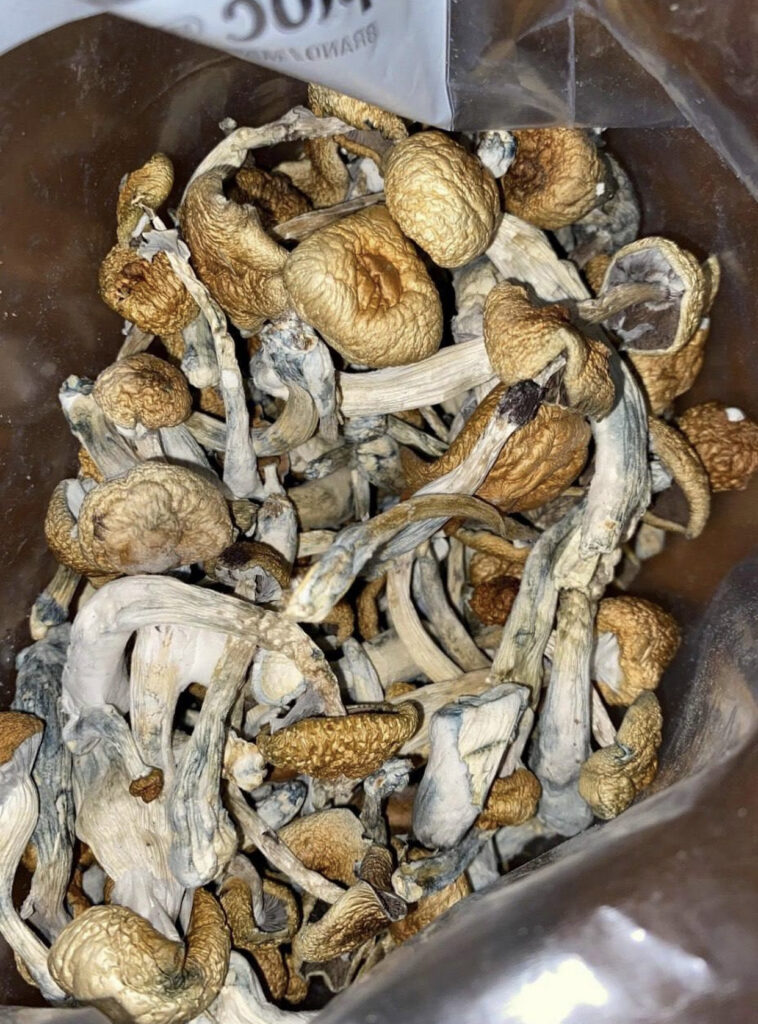
Pingback: buy magic mushrooms microdose - Magic Mush Room Delivery United States
Pingback: magic mushrooms for sale oregon - Magic Mush Room Delivery United States
Pingback: BUY PSYCHDELICS IN PORTLAND - Acid Paradise - Magic Mush Room Delivery United States